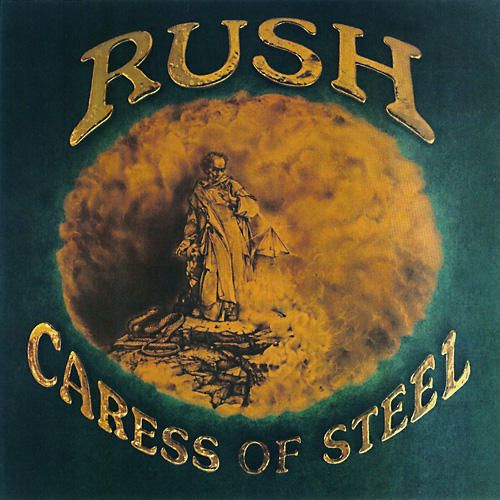
Caress of Steel (1975)

1.Bastille Day
2.I Think I'm Going Bald
3.Lakeside Park
4.The Necromancer
5.The Fountain of Lamneth
Caress of Steel is generally regarded—by fans and the band alike—as the most bewildering chapter in the Rush story. Initially it had few defenders who tended to describe it as “overlooked” or “underrated,” which often feels like code for “I’ve listened to it enough times to make peace with it.” Later fans would be more kind. But let’s be fair. This was their third album in just over a year, and the musical overhaul prompted by Neil Peart’s arrival meant the band was still recalibrating. The ambition was present, but the craft had yet to catch up.
Much of the disappointment stems from the fact that Fly by Night was such an assured and promising leap forward from the group’s hard-rock debut. Expectations were high, and many expected a further upward trajectory. What they got instead was a peculiar misfire—more brave than brilliant.
The record opens promisingly. Bastille Day is a ferocious call to arms, and a spiritual successor to Anthem from the previous album. Lifeson plays with authority, the riffs are crisp, and the energy is palpable. Unfortunately, it’s a quick slide downward from there. I Think I’m Going Bald is an ill-conceived attempt at humor—its title alone suggests the sort of locker-room banter that probably should have stayed off the tape. Lakeside Park is more sincere in intent, aiming for wistful nostalgia, but it falls flat as a would-be single. Geddy’s voice, never one for subtlety, doesn’t quite sell the sentiment.
Peart’s lyrics, often a high point, feel strangely callow this time around. Whether it’s youthful exuberance or simple overreach, lines throughout the record veer into the overwrought and occasionally cringe-worthy. In hindsight, it's clear he was still finding his voice—intellectual but not yet insightful.
The real trouble arrives with the “epics.” There are two of them: The Necromancer (clocking in at 12 minutes) and The Fountain of Lamneth (an exhausting 20-minute suite occupying all of side two). Both aim for grandeur but collapse under the weight of their own self-importance. The Necromancer revisits the By-Tor and the Snow Dog universe with spoken-word interludes (run through some regrettable voice-altering effect), and while occasional instrumental passages hint at something more compelling, the song never truly coheres. A narrative exists, technically—but it’s buried under enough sonic rubble to make comprehension optional.
Then there’s The Fountain of Lamneth, a six-part saga that should have been the album’s centrepiece. Instead, it becomes a cautionary tale about unchecked ambition. The opening movement, In the Valley, holds some promise with its strong melodic lines and dynamic shifts, but the piece quickly derails. The second section, Didacts and Narpets, is a cacophony of drum fills and shouted syllables—presumably symbolic, but more likely baffling. The rest of the composition tries to regain its footing but fails to land any significant emotional or musical punch. There are moments of clarity, but they are brief and quickly buried beneath layers of misguided intent.
Even the tour that followed was a misadventure. Audiences were lukewarm, the record didn’t sell, and the band found themselves on the verge of collapse. Thankfully, they held on. Caress of Steel may have threatened to derail them, but the band soon realized the only way forward was to double down on everything that made them unique. The next album would see the course corrected in spectacular fashion.
Go back to the main page
Go To Next Review